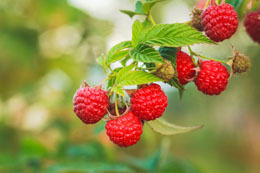In patio gardening, growing raspberries in containers is carried out in large pots having a diameter of 15 inches and more. Suitable potting mix, adequate sunlight, moist soil and support system are some factors required for healthy growth of potted raspberries.

Planting raspberries in outdoor gardens is indeed a rewarding experience for fruit growers. The fresh, juicy berries harvested from a home garden simply taste great. The unfortunate part is, only some of us have a garden for growing fruit plants. However, you don't let your interest down for not having sufficient space or suitable planting soil. Even in such circumstances, you can enjoy the experience of growing and harvesting homegrown raspberries. Yes, these summer fruits are very easy to maintain in pots.
How to Grow Raspberries in Containers?
Whether you are growing raspberries in garden beds or in containers, expose them to bright light for maximum hours. If not possible, they can tolerate partial shade too. The planting soil should be moist, well-drained, slightly acidic (pH 5.6-6.2) and fertile for maintaining productive raspberry plants. Instead of planting them in a waterlogged soil, it is always better to use pots filled with porous potting mix. Things that you should consider for container gardening raspberry plants are as follows.
Begin with Container Selection
Raspberries are perennial and they continue to grow in the same pots for many years. So, choosing appropriate sized containers is a must for getting a continuous supply of ripe berries without transplantation. Preferably, the pots should be about 15-24 inches in diameter. Plastic pots are better than the clay ones to retain water as much as possible. Do not forget to drill drainage holes at the bottom of the pots.
Choose the Raspberry Variety
Besides regular red raspberries, you can plant gold, purple and black raspberries. However, as you are growing raspberries in containers, the size and spread of the plant should be taken into consideration. Varieties that do not require large space are preferred over those that grow vigorously. The best raspberry cultivars for container gardening are Autumn bliss, Anne, Munger, Royalty and Brandywine.
Working with Potting Medium
Lay a wire mesh on the inside of the pot to cover the drainage holes. This will reduce soil from washing away unnecessarily. When it comes to filling soil for container raspberries, it is better to use ready-made potting mix. For preparing soil on your own, you will need to supplement organic matter and additional components to garden soil. One major issue with garden soil is, it contains weed seeds, unwanted plants and pathogens, which negatively affect plant growth.
Planting Raspberry in Pots
For container plantation of raspberries, you can start with seeds or plantlets. Though seeds are less expensive, they require more time for germination and transplantation. So, you can consider buying disease resistant plantings from nursery centers. Make a deep planting hole in the edge of the pot (24-inch diameter), and place a plantlet. Refill soil and press top soil firmly. Continue planting 5 raspberries in the same way. Provide sufficient water to the newly planted raspberries.
Care for Potted Raspberries
First of all, raspberries grown in containers need a support system, and you can use bamboo poles for the same. Always keep the potting medium moist (but not wet), which means proving 1-2 inches of water every week. Avoid watering in excess, as it will cause water logging. Mulching potted raspberries with wood chips, bark pieces and pine leaves is beneficial to prevent weed growth, and reduce water evaporation.
Potted Raspberry Problems
An advantage of growing raspberries in pots is, easy control over pest and disease infestations. Keep a watch over the plant parts for any signs of diseases and pests. Two of the most common pests that attack raspberry plants are tarnished plant bug and cane borer. Pick them manually at the first sight, and remove severely affected leaves (if any). Other raspberry plant problems are crown galls, mite infestation, fungal attack, root rot and nutrient deficiency.
Prune Old Raspberry Canes
Timely pruning of container raspberry plants is the key to get a good yield. So, when is the best time to prune raspberries? It depends on when the fruits actually ripen. If you have grown summer-fruiting raspberry, trim the old canes immediately after harvesting is over. Likewise, pruning time varies for plants that produce ripe berries in September and October. New suckers will develop from the rootstock in spring, and produce berries for that season.
Generally, potted raspberries do not require fertilizer in the first year. From the second year, you can apply a low dose of regular fertilizer (10-10-10) or compost during the active growing period. For those who are into growing raspberries indoors, using fertile soil and providing adequate light are the prerequisites. Besides these, the tips to grow raspberries in containers and ways to care for them remain the same as above.






 Planting raspberries in outdoor gardens is indeed a rewarding experience for fruit growers. The fresh, juicy berries harvested from a home garden simply taste great. The unfortunate part is, only some of us have a garden for growing fruit plants. However, you don't let your interest down for not having sufficient space or suitable planting soil. Even in such circumstances, you can enjoy the experience of growing and harvesting homegrown raspberries. Yes, these summer fruits are very easy to maintain in pots.
Planting raspberries in outdoor gardens is indeed a rewarding experience for fruit growers. The fresh, juicy berries harvested from a home garden simply taste great. The unfortunate part is, only some of us have a garden for growing fruit plants. However, you don't let your interest down for not having sufficient space or suitable planting soil. Even in such circumstances, you can enjoy the experience of growing and harvesting homegrown raspberries. Yes, these summer fruits are very easy to maintain in pots.